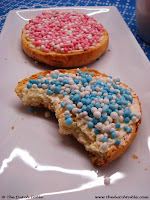 My grandpa Tinus always loved old-fashioned, hearty farm food: liverwurst, blood sausages, balkenbrij.... all those wintery, solid foods that for many of us belong to a different era. It is food that is not readily available at the butcher shop or grocery store anymore, except for a few artisan butchers that still take pride in producing local, traditional, old-fashioned products. But the other day, I ran into a lady of Dutch descent who told me that each year, she and her sisters make balkenbrij, another one of those offal dishes, for Christmas, at home. Much to the horror of everybody else, but they love it and enjoy the process of making and baking it.
My grandpa Tinus always loved old-fashioned, hearty farm food: liverwurst, blood sausages, balkenbrij.... all those wintery, solid foods that for many of us belong to a different era. It is food that is not readily available at the butcher shop or grocery store anymore, except for a few artisan butchers that still take pride in producing local, traditional, old-fashioned products. But the other day, I ran into a lady of Dutch descent who told me that each year, she and her sisters make balkenbrij, another one of those offal dishes, for Christmas, at home. Much to the horror of everybody else, but they love it and enjoy the process of making and baking it. The old days of home hog butchering and using up all the goodies is far removed from many of us, and we flinch at the thought of grinding up livers, chopping up kidneys or stirring buckets of blood into flour in order to make bakleverworst, balkenbrij or Dutch boudin, bloedworst. But there is nothing wrong with reaching back to the cooking of our grandparents, or great grandparents. Their cooking was honest, solid, and tasty. Remember, they didn't have all the fancy entertainment options we have nowadays, so food was something everybody looked forward to and was often a source of bringing people together.
One of those by-product foods is liverwurst, or leverworst. The Dutch like their leverworst and purchase it in a variety of options: as a soft, spreadable Braunschweiger-like leverworst for the lunch sandwich, a harder and sliceable ring-shaped leverworst as a cold snack, or in chunks and pickled in huge vats of vinegar (zure leverworst) and available from your local patatkraam or neighborhood fry shop. A not so familiar one is the bakleverworst, a solid liverwurst that you cut in thick slices, dip in flour and fry up in some butter. It's good eaten cold, after being fried, or warm on a slice of bread.
Embrace your inner grandparent and decide that this winter you are going to venture out and try some of these old traditional dishes from long ago. They are easy to make, and easy to keep.
Bakleverworst
2 lb pork liver
2 lb pork shoulder

5 slices of thick sliced smoked bacon
1 onion
1 tablespoon salt
2 teaspoons ground cloves
2 teaspoons ground white pepper
1 bouillon cube
1/2 cup flour
Bring a large pot with water to a boil, add the bouillon cube or stock and lower to a simmer. Cut the liver and meat into cubes and simmer in the stock for fifteen minutes.
Grind the meat, batch for batch, in a food processor or meat grinder. Depending on whether you want a coarser grind or finer grind, you may have to put the meat through several times. I processed it twice to get a finer texture.
Chop the bacon into small dice and mix through the meat, add the spices and the flour. Mix together. Add a tablespoon of cooking liquid at a time to get a mixture moist enough to be malleable but still solid.
 Measure out about 22 oz per sausage, a little bit more or less doesn't matter, just make sure they all have the same weight.
Measure out about 22 oz per sausage, a little bit more or less doesn't matter, just make sure they all have the same weight. Place a piece of plastic food film on the counter, form the sausage and place it in the middle, lengthwise. Now take the ends of the film and tighten them up, rolling the sausage back and forth on the counter, until it's the right shape. Tighten a knot on each end, cut off the remaining film and wrap in another piece of food film, now wrapping it width-wise. Finish with wrapping each sausage lengthwise again, tying off the knots (see picture) and cutting the remaining film.
Bring a large pan with water to a boil, and place the sausages in the water. Make sure that all wrappings are watertight. Leave it simmering for an hour, remove and shock the liverwurst by placing it in a tray with ice cold water. Let it rest until cold (thirty minutes), unwrap and pat each sausage dry. Rewrap, and refrigerate or freeze for later use.
The next day, slice thick slices from the refrigerated liverwurst, dip them in flour and fry them brown and crispy on the outside. Butter a slice of bread, add the bakleverworst and yum!!! Good old fashioned winter food, love it!!








































